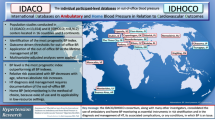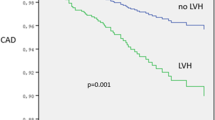Abstract
Long-term population surveys and studies of untreated hypertensive patients both strongly suggest that over the age of about 45, the height of the systolic blood pressure is a better predictor of cardiovascular outcome than the diastolic pressure. Research into echocardiographic left ventricular size, endothelial function and thromborheology also back up this supposition. In clinical practice, the treatment of isolated systolic hypertension has been shown to be very worthwhile. There remains some uncertainty as to the relative significance of diastolic blood pressure when it is frankly high, as in severe systo-diastolic hypertension. However some clinicians and epidemiologists have questioned whether diastolic pressure is still worth measuring, given the overwhelming importance of the height of the systolic blood pressure at predicting outcome.
This is a preview of subscription content, access via your institution
Access options
Subscribe to this journal
Receive 12 digital issues and online access to articles
$119.00 per year
only $9.92 per issue
Buy this article
- Purchase on Springer Link
- Instant access to full article PDF
Prices may be subject to local taxes which are calculated during checkout
Similar content being viewed by others
References
May O, Hyperpiesia IV . Mortality in relation to hyperpiesia. Br Med J 1925; ii: 1166–1167.
Kannel WB, Gordon T, Schwartz MJ . Systolic versus diastolic blood pressure and risk of coronary heart disease. Am J Cardiol 1971; 27: 335–345.
Lichtenstein MJ, Shipley MJ, Rose GA . Systolic and diastolic blood pressure as predictors of coronary heart mortality in the Whitehall Study. Br Med J 1985; 291: 243–245.
Franklin SS et al. Is pulse pressure useful in predicting risk for coronary heart disease? The Framingham Heart Study. Circulation 1999; 100: 354–360.
Wilking SVB et al. Determinants of isolated systolic hypertension. JAMA 1988; 260: 3451–3455.
Zakopoulos NA et al. Pulse pressure in normotensives, a marker for cardiovascular disease. Am J Hypertens 2001; 14: 195–199.
Staessen JA et al. Risk of untreated and treated isolated systolic hypertension in the elderly: meta-analysis of outcome trials. Lancet 2000; 355: 865–872.
White WB, Dey MH, Shulman P . Assessment of the daily blood pressure load as a determinant of cardiac function in patients with mild to moderate hypertension. Am Heart J 1989; 118: 782–795.
Papademetriou V et al. Similar effects of isolated systolic hypertension and combined hypertension on left ventricular geometry and function. The LIFE Study. Am J Hypertens 2001; 14: 768–774.
Lip GYH, Blann AD, Beevers DG . Prothrombotic function, endothelial function and left ventricular hypertrophy in isolated systolic hypertension compared with systo-diastolic hypertension. J Hypertens 1999; 17: 1203–1207.
SHEP cooperative Research Group . Prevention of stroke by antihypertensive drug treatment in older persons with isolated systolic hypertension. JAMA 1991; 265: 3255–3264.
Staessen JA et al. Randomised double-blind comparison of placebo and active treatment for older patients with isolated systolic hypertension. Lancet 1997; 350: 757–764.
Beevers DG, Davies P, Johnston JH, Larkin H . The relative importance of systolic, diastolic and mean arterial pressure treated hypertensives. Br J Clin Pract, Symp Suppl 1982; 15: 1–5.
Sever PS . Abandoning diastole. Br Med J 1998; 318: 1773.
Strandberg TE et al. Isolated diastolic hypertension: pulse pressure and mean arterial pressure as predictors of mortality during a follow-up of up to 32 years. J Hypertens 2002; 20: 399–404.
Cox DR . Regression models and life tables. J R Stat Soc B 1972; 34: 187–220.
He J, Whelton PK . Elevated systolic blood pressure or a risk factor for cardiovascular and renal disease. J Hypertens 1999; 17 (Suppl 2): S7–S13.
Black HR . The paradigm has shifted to systolic blood pressure. Hypertension 1999; 34: 386–387.
Swales JD . Systolic versus diastolic pressure: paradigm shift or cycle? J Human Hypertens 2000; 14: 477–479.
Rose GA . Personal Communication, 1990.
Author information
Authors and Affiliations
Corresponding author
Rights and permissions
About this article
Cite this article
Beevers, D. Epidemiological, pathophysiological and clinical significance of systolic, diastolic and pulse pressure. J Hum Hypertens 18, 531–533 (2004). https://doi.org/10.1038/sj.jhh.1001702
Published:
Issue Date:
DOI: https://doi.org/10.1038/sj.jhh.1001702
Keywords
This article is cited by
-
Systolic Blood Pressure and Adiposity: Examination by Race and Gender in a Nationally Representative Sample of Young Adults
American Journal of Hypertension (2012)



